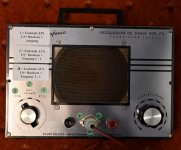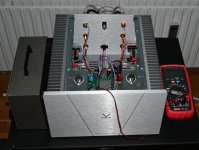Are Tango now those called ISO or ISO-Tango like these:
SINGLE ENDED OUTPUT TRANSFORMERS. By ISO transformers from Japan, formerly TANGO transformers.
My 300B amp is more or less DIY as it is modified a lot and will compare with VFET to check how close there are. I managed to get the 300B "hum free" with help from some "tube gurus".
The good thing with low voltage amps is that 1. time builders can do it. With tube amps more care has to be taken. 1000 uF 550VDC can give a "good" kick.
SINGLE ENDED OUTPUT TRANSFORMERS. By ISO transformers from Japan, formerly TANGO transformers.
My 300B amp is more or less DIY as it is modified a lot and will compare with VFET to check how close there are. I managed to get the 300B "hum free" with help from some "tube gurus".
The good thing with low voltage amps is that 1. time builders can do it. With tube amps more care has to be taken. 1000 uF 550VDC can give a "good" kick.
it would be funny to go to a hifi store with it and say can i compare my Diy amp to your big dollars ones 😀
Would you compare with a Passlabs amp? 🙂
I have now prepared for a re-flow job this evening. Then I also made this modification I have seen other been doing so it is easier to mount again. Then I don't have to fiddle with the plastic spacers.
Can you, please, describe a bit what this helps with? I am still waiting on the parts, but would be useful to know before hand. Thanks.
Rafa,
The metal pcb stand offs are botled to the bottom plate, having femald threads.
No need to slide the plastic stand odc over the screw dtc...
The metal pcb stand offs are botled to the bottom plate, having femald threads.
No need to slide the plastic stand odc over the screw dtc...
Can you, please, describe a bit what this helps with? I am still waiting on the parts, but would be useful to know before hand. Thanks.
The solder re-flow was to check if the very faint noise I had in R-channel was caused by a bad solder joint. I don't expect it but I try it out. It is very faint noise not audible with year 20cm from tweeter but L-channel is 100% silent with ear few cm from tweeter. I am just obsessed by symmetry 🙂
Then I also made some small adjustments on chassis. Rail adjustment etc. so chassis looks nicer when assembled. Not finished yet.....but almost there......
I was surprised that the nuts that secures the TO-3's to PCB and also should make electrical contact to PCB seems a bit on the loose side......so I made them a bit more tight. Maybe for this job people here talked a lot of torque screwdrivers?
Regarding the metal stand offs I reverted back to the originals and it was not that hard to get it fit.
The stand offs I mounted......the screws was not able to get through the holes in PCB. Then I tried 3mm hardware.....but it did not work well.....so went back to the original.
Think 4mm hardware should do it and the first stand offs I used must have been larger.
The stand offs I mounted......the screws was not able to get through the holes in PCB. Then I tried 3mm hardware.....but it did not work well.....so went back to the original.
Think 4mm hardware should do it and the first stand offs I used must have been larger.
I understood that, one of the reason for Mr. Pass pre-assembling the VFETs was, precisely, to avoid torque forces on the fet due to over-tension on the nuts. Was it really lose? I would be afraid of damaging the unobtanium. I probably would check the bolts myself, but not tight them when they have been torqued-calibrated screwed in....I was surprised that the nuts that secures the TO-3's to PCB and also should make electrical contact to PCB seems a bit on the loose side......so I made them a bit more tight. Maybe for this job people here talked a lot of torque screwdrivers?
metal cases are not that critical for torque, per se
what can be critical with T03 cases (small area around screws) - over-torque and puncture of thermal pad, if soft ones are used ..... simply because ends of "ears" are bending
but, still not overly critical
what can be critical with T03 cases (small area around screws) - over-torque and puncture of thermal pad, if soft ones are used ..... simply because ends of "ears" are bending
but, still not overly critical
R-channel still makes a bit of "flicker-noise".
They funny thing is that suddenly it is gone and total silence even with ear close to tweeter. Is that the nature of this kind of noise?
But it does not affect quality of the music.
If I was not trying out passive pre i would probably never have experienced it. With passive pre I have low amplification in the chain and then also very low noise level.
They funny thing is that suddenly it is gone and total silence even with ear close to tweeter. Is that the nature of this kind of noise?
But it does not affect quality of the music.
If I was not trying out passive pre i would probably never have experienced it. With passive pre I have low amplification in the chain and then also very low noise level.
replace trimpot, you'll know more
in a meantime, try to relax and listen to some music
besides, you're sole lucky guy, everyone else got sand lottery amp, you got tube one

in a meantime, try to relax and listen to some music
besides, you're sole lucky guy, everyone else got sand lottery amp, you got tube one

I will order some 25k pots.....only have 5k and 10k of those types.
It would make sense if this pot is noisy as the wiper of the pot goes to the gate of the VFET. The 20V seems very stable after warm up but pot can still make some troubles it seems. It is not the most funny to unsolder......but let's see.....
Amp has played some nice music during the evening. It is silent now (switched off).
It would make sense if this pot is noisy as the wiper of the pot goes to the gate of the VFET. The 20V seems very stable after warm up but pot can still make some troubles it seems. It is not the most funny to unsolder......but let's see.....
Amp has played some nice music during the evening. It is silent now (switched off).
replace trimpot, you'll know more
in a meantime, try to relax and listen to some music
besides, you're sole lucky guy, everyone else got sand lottery amp, you got tube one

ROTFL! Bad ZM!
In my ACA I had something similar. Replaced all active divices; replaced output resistors. In the end someone gave the tip: the input coupling cap. And yes, that gave that intermittent clicking hushy flickering noise. Replaced it. It was gone. So I'd say: look at C4 (D- input) or C1 grand input or C2 (buffer, unlikely).R-channel still makes a bit of "flicker-noise".
They funny thing is that suddenly it is gone and total silence even with ear close to tweeter. Is that the nature of this kind of noise?
But it does not affect quality of the music.
If I was not trying out passive pre i would probably never have experienced it. With passive pre I have low amplification in the chain and then also very low noise level.
It puzzles me that it is dependent on the preamp (passive you hear it, active not). Then it looks like the vol pot.
imho Trimpot noise is totally blanked out by the C2/1000uF.
With active preamp the preamp also contributes to the audible noise in tweeter so when the passive was installed I noticed the "silence" apart from the "clicking" noise from time to time. It is the same with input shorted. But to get a feeling for if the noise could be from the trimpot I used my old amplifying device and coupled it to speaker out. Then I can hear the output noise in 5m distance instead of 5cm. Then I "played" with trimpot. And it is very obvious that just touching the white trim screw with screwdriver creates this noise. And of course turning it creates a lot of noise. I think there is a high probability that trimpot is "noisy". It may also explain why noise can come and go.
Think I will get some 25k pots and see if it cures it.
To unsolder the old I may use a SMD "heat gun" which has some attachments that can direct the heat at a concentrated spot.....or is that a bad idea?
The idea was to heat all 3 terminal at same time for a quick easy removal.
Think I will get some 25k pots and see if it cures it.
To unsolder the old I may use a SMD "heat gun" which has some attachments that can direct the heat at a concentrated spot.....or is that a bad idea?
The idea was to heat all 3 terminal at same time for a quick easy removal.
Attachments
@ Meper
Step two heat all 3 terminals at the same time is a good idea for easy removal..
but first step can be individualy suck joints with desoldering pump
so you get much less of the solder to "fight" with in step two 🙂
Step two heat all 3 terminals at the same time is a good idea for easy removal..
but first step can be individualy suck joints with desoldering pump
so you get much less of the solder to "fight" with in step two 🙂
Good idea!
Seems some trimpots uses a brush as wiper and other (Bourns) uses "multi-wire":
Trim potentiometers – Passive Components Blog
Those "BI-Technology" trimmers are they "also" quality trimmers?
Seems the "BI-Technology" multiturn trimmer uses a brush as wiper but have no idea if this is good or bad.....
Seems some trimpots uses a brush as wiper and other (Bourns) uses "multi-wire":
Trim potentiometers – Passive Components Blog
Those "BI-Technology" trimmers are they "also" quality trimmers?
Seems the "BI-Technology" multiturn trimmer uses a brush as wiper but have no idea if this is good or bad.....
- Home
- Amplifiers
- Pass Labs
- DIY Sony VFET Builders thread


